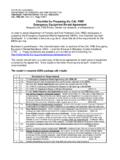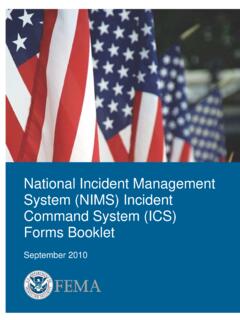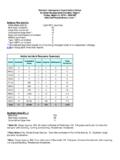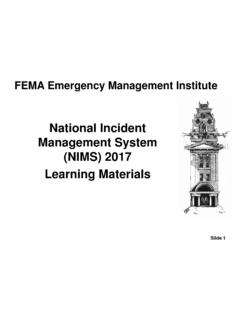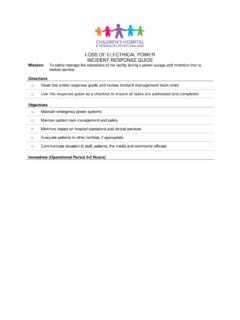Transcription of Controlling fire and explosion risks in the workplace
1 Page 1 of 9 Health and Safety ExecutiveControlling fire and explosion risks in the workplaceA brief guide to the Dangerous Substances and Explosive Atmospheres Regulations This is a web-friendly version of leaflet INDG370(rev1), published 01/13 Introduction to DSEARThis leaflet provides a brief introduction to the requirements of the Dangerous Substances and Explosive Atmospheres Regulations 2002 known as ,2 It explains what employers may need to do to protect their employees from fire and explosion risks . It will also be useful to employees and their Regulations aim to protect people from fire and explosion risks related to dangerous substances and potentially explosive atmospheres.
2 DSEAR places duties on employers to protect people from risks to their safety from fires, explosions and similar events in the workplace . These duties also apply to those self-employed people whose work activities may pose a risk to others. What is a dangerous substance?Dangerous substances are any substances used or present at work that could, if not properly controlled, cause harm to people as a result of a fire , explosion or similar incident, such as an uncontrolled chemical reaction. They can be found in nearly all workplaces and include such things as solvents, paints, varnishes, flammable gases, liquefied petroleum gas (LPG), dusts from machining and sanding operations, and dusts from substances do not include all materials that can catch fire in the workplace .
3 However, some materials that can cause the rapid escalation of a fire if handled in a certain way are also classed as dangerous substances under DSEAR (eg cellular plastic foams).What is an explosive atmosphere?An explosive atmosphere is a mixture of a dangerous substance or substances (gas, mist, dust or vapour) with the air, which has the potential to catch fire or explode. An explosive atmosphere does not always result in an explosion but, if it does catch fire , the flames travel quickly. If this happens in a confined space (eg in plant), the rapid spread of the flames or rise in pressure could also cause an and Safety ExecutiveControlling fire and explosion risks in the workplace Page 2 of 9 When does DSEAR apply?
4 The Regulations apply to the majority of work activities, including those carried out in moveable structures, outdoor areas and domestic premises, where:work is being carried out by an employer (or self-employed person); a dangerous substance is present (or is liable to be present or generated) at the workplace ;a potentially explosive atmosphere may occur; the dangerous substance and/or potentially explosive atmosphere could be a risk to the safety of people as a result of fires, explosions or similar energetic events. For example, DSEAR covers the following activities:storage and use of flammable liquid-based paints and inks; storage of LPG; storage and use of oxygen; storage and transport of powders in pharmaceutical and food industries; storage and display of flammable goods, such as paints in shops; handling and storage of flammable waste solvents; welding or other hot work on tanks and drums that have contained flammable material;use of flammable gases, such as acetylene, for welding; use of flammable solvents in laboratories.
5 Transport of flammable substances in containers around a workplace ; deliveries from road tankers, such as flammable liquids, gases and bulk powders;chemical manufacturing, processing and warehousing. What must I do to comply?DSEAR places duties on employers and the self-employed (considered employers for the purposes of the Regulations) to assess and eliminate or reduce risks from dangerous substances so far as is reasonably practicable. To comply you should do the following. Assess the risksWhere a dangerous substance is, or is liable to be, present in the workplace the employer should assess the risk of harm this poses to people in the event of a fire , explosion or similar event.
6 Ideally, you should carry out a risk assessment in relation to DSEAR as part of the overall workplace risk assessment required under the Management of Health and Safety at Work Regulations You may also find it convenient to carry out the risk assessment in combination with that required under the general fire precautions legislation in the workplace the Regulatory Reform ( fire Safety) Order 2005 and the fire (Scotland) Act information about risk assessments can be found on HSE s risk management The risk assessment under DSEAR includes five steps:Health and Safety ExecutiveControlling fire and explosion risks in the workplace Page 3 of 9 Step 1 Identify the fire and explosion hazards and hazards from similar energetic events This should be an identification and careful examination of:the dangerous substances present, including those that may be formed in the workplace ;the potential ignition sources of the dangerous substances; the work activities involving the dangerous substances; the possible formation and extent of explosive atmospheres.
7 The scale of the anticipated effects from the fire , explosion or similar energetic event. The supplier s Material Safety Data Sheet should provide key information on the properties and hazards of the dangerous substance to assist you in this task. It should also provide information on the safe methods for the storage, use and handling of the dangerous substance, or make reference to where this may be found. Step 2 Decide who might be harmed and how Identify the people at risk from the fire , explosion hazards or similar energetic event involving the dangerous substance. Based on your consideration of the anticipated effects of the incident, determine who might be potentially harmed by it.
8 This includes members of the public who might be put at risk by the work 3 Evaluate the risks and decide on precautions You should determine whether the measures taken are adequate to eliminate or reduce the risks from dangerous substances, so far as is reasonably practicable. This should take account of such things as: the possible substitution of the dangerous substance by one that is non- hazardous, or one that is less hazardous; the control measures to prevent a fire , explosion or similar energetic incident from occurring;the mitigation measures to limit the scale and magnitude of the incident should it occur.
9 Step 4 Record your findings and implement control measures If you employ five or more employees, you should record the significant findings of your risk assessment. This should include the location and extent of explosive atmospheres and their classification in terms of risk assessment should also help you decide on:the information, instruction and training you give to your employees. This should be sufficient for them to safeguard themselves and others from the risks presented by the dangerous substances; the arrangements to deal with accidents, incidents and emergencies, including involvement of the emergency services.
10 Health and Safety ExecutiveControlling fire and explosion risks in the workplace Page 4 of 9 Step 5 Review your risk assessment and update if necessary If you introduce significant changes to your workplace , such as changing the dangerous substances present or their quantities, or changing the work equipment or processes, you should review your risk assessment. Similarly, you should do this in the event of an incident, including a near miss for example a release of a dangerous substance without ignition to determine if the measures you have in place are sufficient. You should carry out a risk assessment regardless of the quantity of dangerous substance present, as it will enable you to decide whether existing measures are sufficient or whether any additional controls or precautions are necessary.











